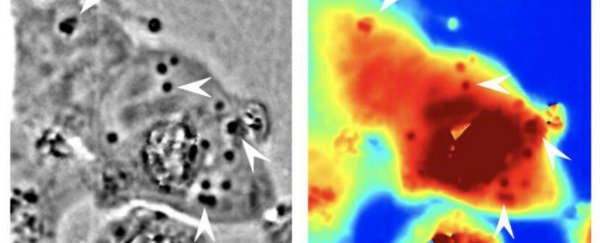The opalescent inshore squid has a superpower. Not only can it change the colour of its skin - which many chephalops can do - it can also turn parts of itself invisible. Now, scientists have used this ability on human cells.
Using special proteins found in the cells of these changeling squids, researchers managed to apply them to human kidney cells. Their findings could help us to better understand various cellular mechanisms in living tissue.
"Our project centres on designing and engineering cellular systems and tissues with controllable properties for transmitting, reflecting and absorbing light," explained biomolecular engineer Atrouli Chatterjee from the University of California (UCI).
 A female opalescent inshore squid with her eggs. (Brent Durand/Moment/Getty Images)
A female opalescent inshore squid with her eggs. (Brent Durand/Moment/Getty Images)
Squids aren't the only animals to make use of see-through skin. While gliding lizards (Draco sumatranus) use their skin translucency to draw attention, opalescent inshore squids (Doryteuthis opalescens) use theirs to avoid unwanted attention.
Females of this squid species can turn a white stripe along their backs from opaque white to nearly transparent. They do this using specialised cells called leucophores, which have membrane-bound particles made of reflectin proteins.
Depending on how these proteins are arranged, they can change how light is transmitted or reflected around them. And it's not a random process: Squids can alter the arrangement of these highly refractive proteins within their cells, using an organic chemical called acetylcholine.
To try this trick in human tissue, the research team genetically engineered human kidney cells to produce reflectins, which clumped together as disordered particles in the cell's cytoplasm.
"We were amazed to find that the cells not only expressed reflectin but also packaged the protein in spheroidal nanostructures and distributed them throughout the cells' bodies," said UCI biomedical engineer Alon Gorodetsky.
Using quantitative phase microscopy, the researchers showed these proteins changed the way light was scattering through the engineered cells, compared to kidney cells without reflectin.
They then exposed the reflectin-expressing cells to different levels of sodium chloride and found they could adjust the levels of light being transmitted through them, as the salt made the reflectin particles swell in size, and change how they arranged themselves.
The more salt, the more light scattered, and the more opaque the cells became. The kidney cells now had tunable light-transmitting and light-reflecting capabilities - essentially an opacity dial of sorts.
 Experimental setup. The cells became more opaque after exposure to salt (bottom). (Chatterjee et al, Nat. Commun, 2020)
Experimental setup. The cells became more opaque after exposure to salt (bottom). (Chatterjee et al, Nat. Commun, 2020)
The reflectin's reaction to salt "bore a superficial resemblance to the acetylcholine-triggered switching of the opacity and broadband reflectance for female D. opalescens squids' leucophore-containing layers", the researchers wrote in their paper.
The team says their success lays the groundwork for incorporating other squid tricks into mammalian cells, like changing colour patterns and iridescence.
It will also allow researchers to further explore the mechanisms behind these abilities, as so far, culturing cephalopod skin cells in a lab has proved very challenging.
Possible future applications could include the ability to image entire living tissues with improved clarity - allowing us to find things that weren't apparent before. The team pointed out how similar studies on jellyfish's green fluorescent proteins led to their now popular use in fluorescence microscopy.
"Our findings may afford a variety of exciting opportunities and possibilities within the fields of biology, materials science, and bioengineering," the team concluded.
This research was published in Nature Communications.
